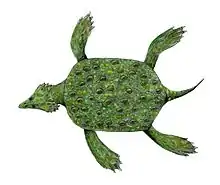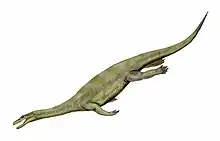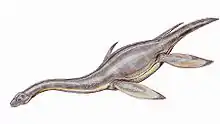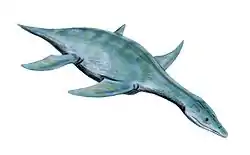Cymatosaurus
Cymatosaurus is an extinct genus of pistosauroid or nothosauriform sauropterygian. It is known to have been alive from the Early Triassic to the Middle Triassic period (latest Olenekian to Anisian stages) of Germany and they seem to originate from the Netherlands.[2][3] It was a small reptile measuring 1–1.2 metres (3.3–3.9 ft) long.[3]
| Cymatosaurus Temporal range: Early-Middle Triassic, | |
|---|---|
 | |
| Cymatosaurus and pachypleurosaur humeri | |
| Scientific classification | |
| Domain: | Eukaryota |
| Kingdom: | Animalia |
| Phylum: | Chordata |
| Class: | Reptilia |
| Superorder: | †Sauropterygia |
| Clade: | †Pistosauroidea |
| Family: | †Cymatosauridae |
| Genus: | †Cymatosaurus Fritsch, 1894 |
| Species | |
See also
References
- Michael W. Maisch (2014). "A well preserved skull of Cymatosaurus (Reptilia: Sauropterygia) from the uppermost Buntsandstein (Middle Triassic) of Germany". Neues Jahrbuch für Geologie und Paläontologie - Abhandlungen. 272 (2): 213–224. doi:10.1127/0077-7749/2014/0407.
- Klein, N. (2010). Farke, Andrew Allen (ed.). "Long Bone Histology of Sauropterygia from the Lower Muschelkalk of the Germanic Basin Provides Unexpected Implications for Phylogeny". PLOS ONE. 5 (7): e11613. Bibcode:2010PLoSO...511613K. doi:10.1371/journal.pone.0011613. PMC 2908119. PMID 20657768.
- Sander, P.M.; Klein, N.; Albers, P.C.H.; Bickelmann, C.; Winkelhorst, H. (2014). "Postcranial morphology of a basal Pistosauroidea (Sauropterygia) from the Lower Muschelkalk of Winterswijk, The Netherlands". Paläontologische Zeitschrift. 88: 55–71. doi:10.1007/s12542-013-0181-5.
This article is issued from Wikipedia. The text is licensed under Creative Commons - Attribution - Sharealike. Additional terms may apply for the media files.






.png.webp)